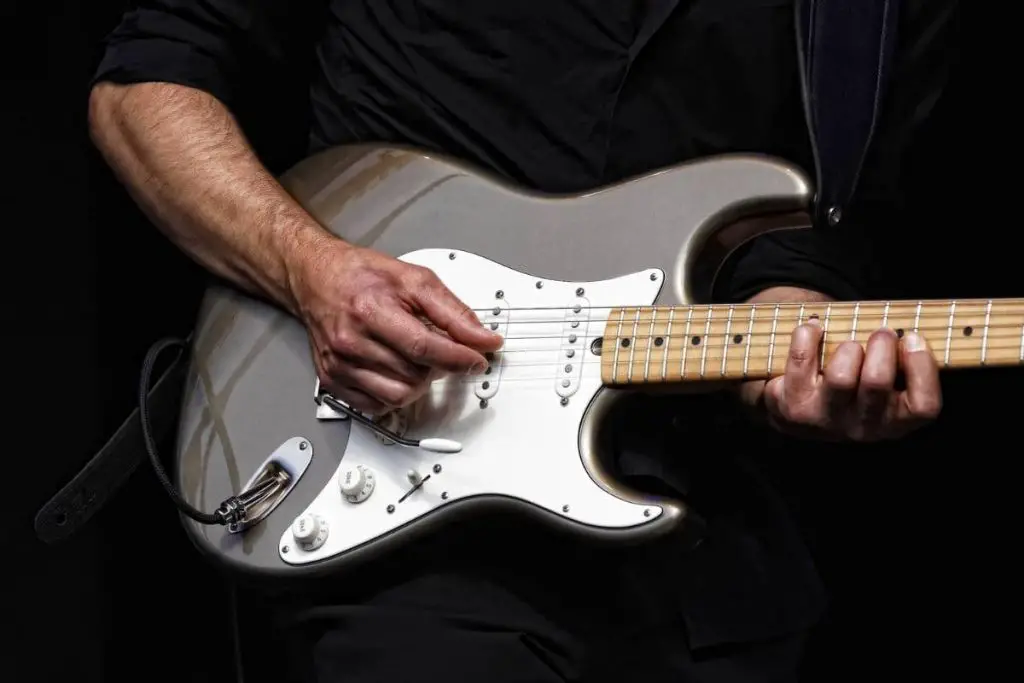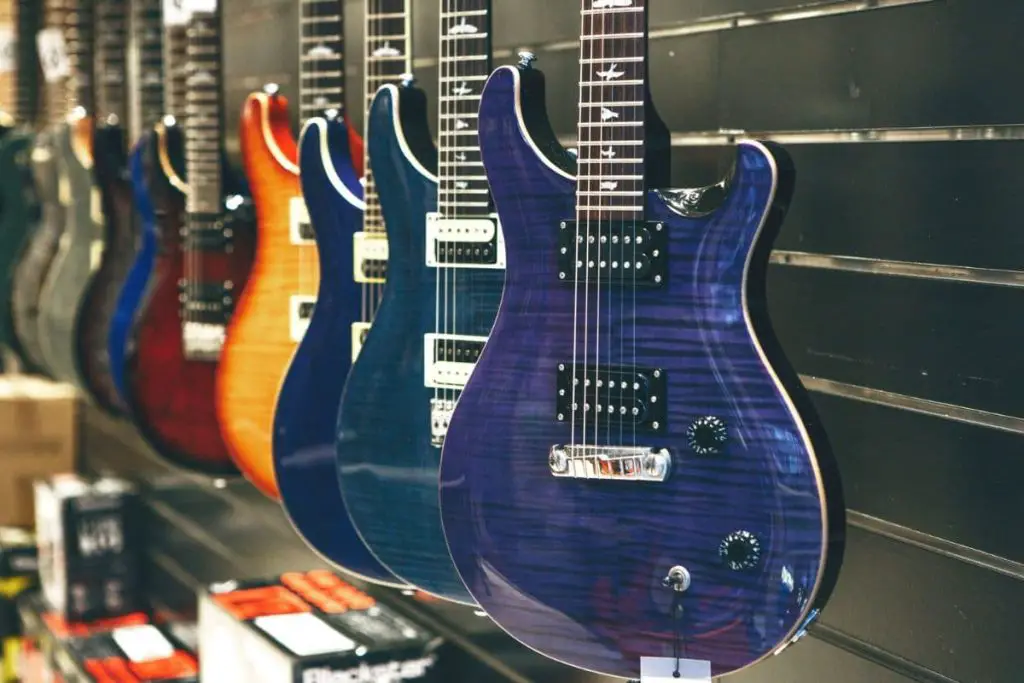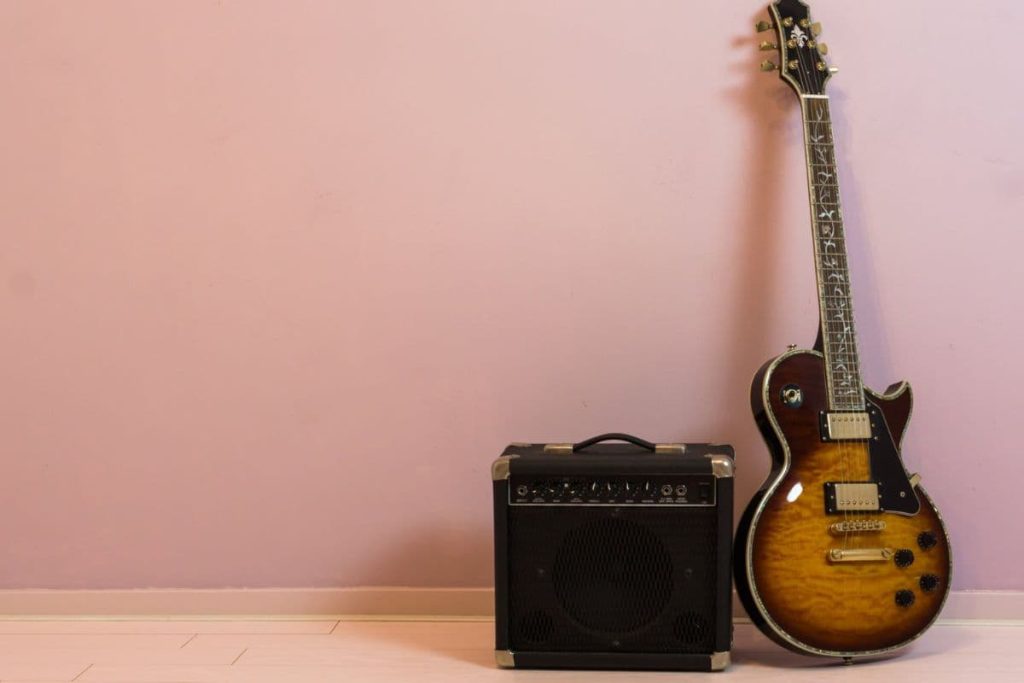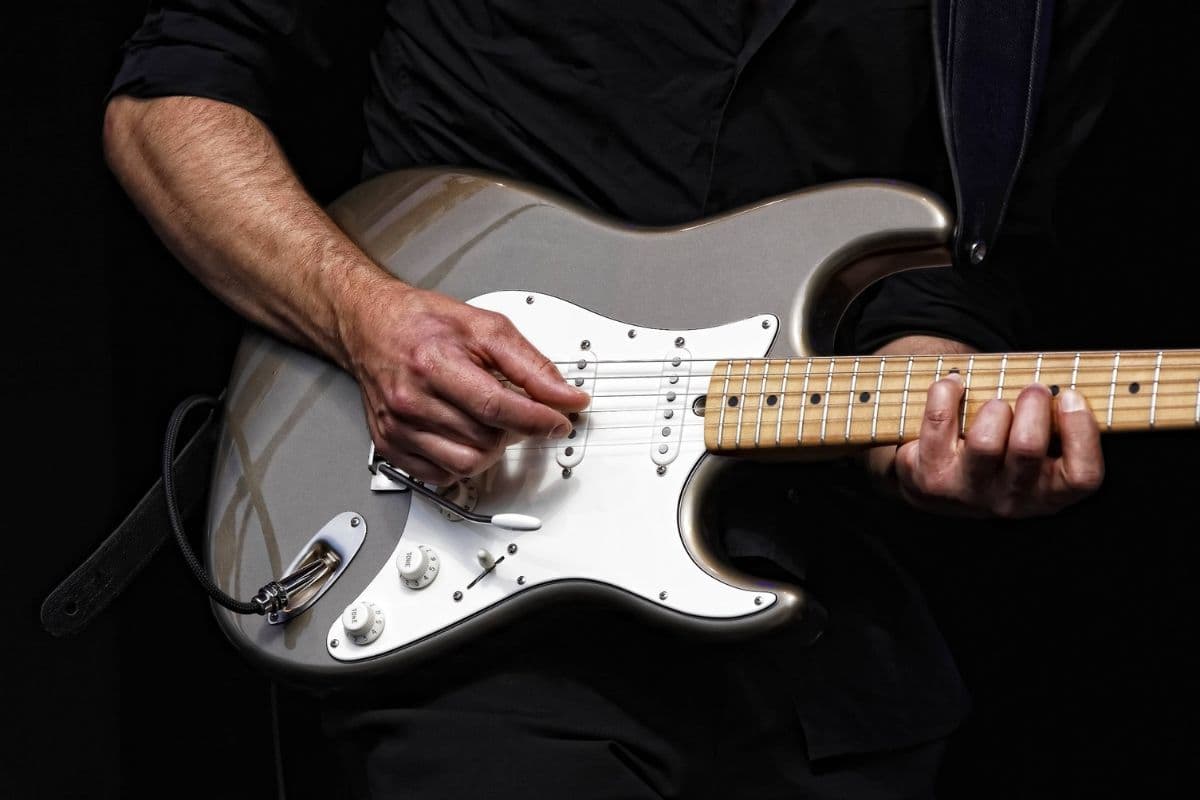Electric guitars come in many shapes and sizes. You may have noticed subtle tonal differences between them. These slight variations in sonic character are not only apparent within the first few minutes of testing out a new axe but continue to come forward as you spend more time playing it.
The reason all electric guitars sound different is due to the pickups, which capture the string’s vibrations and convert them into an electrical signal. The guitar body material also varies the sound, as does your choice of amp. Finally, your playing style affects the type of sound you produce.
You end up with a unique instrument when you combine the size, shape, and materials used to make an electric guitar with its pickups and other features. In this article, I’ll provide more insights into 5 things that bring the differences you hear in electric guitars.
If you want to find out what my recommended guitar gear is, then here is what I recommend on Amazon:
- Fender Cutaway Acoustic-Electric Guitar Bundle (MY FAVORITE GUITAR)
- Snark SN-8 Super Tight All Instrument Tuner (Easiest Tuner I’ve Used)
- 6 String Acoustic Guitar Capo (Best CAPO for quick changes)
- Dunlop Max Grip 1.0mm Nylon Picks (Thick Guitar Pick So You Don’t Lose Grip!)
- Universal Guitar Stand (Cheap & Minimalist Guitar Stand I Recommend)
- Levy’s 2″ Wide Quick Adjust Guitar Strap (Best Guitar Strap For Any Level)

1. Pickups Affect Electric Guitar Sound
Pickups are the core functional components of any electric guitar. They’re the part of the guitar that converts the strings’ vibration into an electrical signal that you may send to an amp for amplification. While pickup design has many variations, single-coil and humbucker are the two most common types.
Basic Anatomy of Single-Coil Pickups and Humbuckers
Single-coil pickups are the most common type of pickup and are recognizable by their individual coils wound around a single core. The basic anatomy of a single-coil pickup includes six bar magnets or metal rods (with a magnet placed underneath the bobbin) inserted into a plastic bobbin. Manufacturers typically wind a wire around the magnets or metal rods.
Humbuckers are a slight variation of the single-coil pickup but with two coils instead of one. Most humbuckers show two rows of bar magnets (called pole pieces) that help channel the magnetic field towards the strings to give you a cleaner sound.
Single-coil pickups produce a brighter sound. Unfortunately, the lack of a second coil makes them prone to noise. Humbuckers are often used instead of single-coils because they have a thicker, richer sound that is less prone to feedback.
Pickup Placement
The pickup’s position on the guitar is also important. Pickups placed at the bridge produce a much brighter sound than if you have them at the neck. Regarding placement, guitar pickups fall into two broad categories, neck and bridge pickups.
The first pickup in a guitar is the neck pickup, and as its name suggests, you will typically find it near the guitar’s neck. The bridge pickup lies near or underneath the bridge. The neck pickup locates clean, mellow tones, and the bridge pickup focuses on a more aggressive sound. The neck pickup is usually closer to the neck of the guitar, where string vibrations are loudest.
The bridge pickup is closer to the bridge, where the strings vibrate less. Bridge pickups pick up brighter sounds. The bridge position also works well for overdrive/distorted sounds.
It’s worth noting that some guitars come with a combination of the two pickups for a more balanced sound between the mid-range and higher frequencies.
2. Body Materials Influence Sound in Electric Guitars
The body of an electric guitar is an essential part of the instrument—the type of wood used to make the body can affect the sound produced by the guitar. Different types of wood resonate at different frequencies, which means that they create different sounds. Some luthiers can combine two or three types of woods to create a unique sound for their guitars.

Different Wood Influences Sound in Electric Guitars
Each type of wood has its own unique sonic properties that give each instrument a different sound and feel. Musicians choose Various kinds of wood for their electric guitars, including maple, mahogany, and ash. The density and type of wood used will also affect your guitar’s overall sound and feel.
Here are the most common types of wood used in electric guitars:
- Maple – Maple is a hardwood commonly used to construct guitars and stringed instruments. It is a dense, strong wood that is easy to shape. Maple bodies produce a bright, crisp sound that works well for many styles of music that need an abundance of high frequencies.
- Mahogany – Mahogany is a dense hardwood that luthiers have opted for in electric guitars for many years. Unlike maple, it creates a warmer, richer sound that works well for many music styles, including rock, blues, and country. Mahogany is often used in constructing the electric guitar body due to its durability and unlikeliness to warp as it ages.
- Ash – Ash is a hard, porous wood commonly used to construct rock and metal guitars. It has a high strength-to-weight ratio, making it easy to produce instruments with a low overall weight. In general, ash has a bright sound that works well with distortion.
- Alder – Alder is a soft hardwood commonly used to construct electric guitars. It produces a balanced sound. The naturally lightweight alder construction makes it an excellent choice for building electric guitar bodies.
- Basswood – Basswood is an excellent choice for its deep tone. Luthiers often opt for this wood for acoustic guitars for the warm, rich sound it produces. Electric guitar bodies of basswood suit country, rock, and jazz due to their warm, full sound.
As you can see, the guitar’s body significantly impacts the sound since it’s part of the vibrating wooden soundboard. The size and shape of the guitar’s body, however, bear no significant direct impact on the sound quality. That’s why electric guitars come in crazy shapes that still sound great.
The Gibson Les Paul, for instance, is instantly recognizable by its rounded and wide body shape. Some guitars come in single cutaways, while others like the Fender Stratocaster feature double cutaways that make it easy to play the strings.
3. Types of Electric Guitar Strings Influence Sound
Electric guitar strings have a massive influence on the sound of your guitar. Electric guitar strings produce very different sounds depending on their composite material and thickness (measured in gauges).

Electric guitar strings fall into the following broad categories:
- Round wound strings – Manufacturers create roundwound strings by wrapping a metal wire around a metal core. Round wound strings have a bright sound and are typically nickel or steel. They last two or three months, depending on how well you care for them.
- Flat wound strings – Manufacturers create flatwood strings by winding a flat piece of metal onto the core of the string. Flat wound strings have a warm and mellow sound that is perfect for jazz. They hold more tension, meaning you must apply some energy when playing them.
- Half round strings – These strings blend flat and round wound strings. They feature a rounded edge with a flat surface wound around a core. This string type reduces noise when changing chords while resting a round wound sound.
How Different Strings Affect Sound
The type of string will affect the sound of your guitar uniquely. The wrapping, material, and tension of the string all affect the sound.
String Gauge and Tension
String gauge is the thickness of the strings. The lower the gauge number, the thinner the string. A thicker string holds more tension, affecting the guitar’s feel and the sound it produces. String gauge also affects the tone of your guitar. A thicker string will create a more consistent sound and more sustain, while a thinner string will sound brighter and crisper.
The string gauge you choose will depend on your personal preference. Most electric guitars have a standard gauge of 10 to 46. If you have a specific guitar in mind, you can check the string gauge from the manufacturer’s site.
String Material
The string material will affect its tone, longevity, and cost. As mentioned earlier, most electric guitar strings are nickel, steel, or nickel-steel alloys. Steel strings suit live play and metal and hard rock genres, with a bright, high-frequency sound that cuts through other sounds. Nickel strings produce a more mellow and warmer tone suited to blues and classic rock.
4. Amp Differences Affect Guitar Sound
Electric guitar amps are the cornerstone of electric guitar tone. Unlike acoustic guitars, electric guitar bodies have no (or limited space in semi-hollow guitars) to amplify the string vibrations through resonance. As such, electric guitars are not audible to most audiences without amplification.
The amp makes the sound produced by the guitar audible and allows you to create different sounds through effects like reverb and distortion.

Electric guitar amps come in a range of sizes, wattage outputs, and features. Some of the most common features that set these amps apart include:
Tone Controls
These are a series of knobs and switches that let you modify the basic sound of the guitar by adding or removing bass, treble, and middle frequencies. Most amps will have at least one tone knob, while a more luxurious model might have two or three. The more tone controls you have, the more precise you can be with your sound.
Speakers
As the part of the amp that does the actual production of the sound your audience hears, speakers are essential to determining the amp’s overall sound. A cheap amp might have one speaker, while a premium option will have two or three.
Individual speakers inside guitar amps may sound different if you’re attentive to the details. However, it is the tone controls that make each guitar sound different.
Amp Brands
It’s no secret that different amp brands sound different. Even the highest-quality amps use different circuitry arrangements to alter the sound. Let’s start with the Orange Micro Terror Guitar Amp (available on Amazon.com). This amp is a small, affordable solid-state amp compatible with any speaker cabinet. It provides a clean, warm tone and still packs a punch despite its small size. You can tweak the output with tone control, volume, and gain.
Tube amps, on the other hand, use vacuum tubes to amplify sound. Tube amps produce warm, natural-sounding tones that have a lot of depth. They are generally louder than solid state amps, but they tend to be heavier as well. You would expect a JOYO Tweedy BanTamp Mini Amp (available on Amazon.com) to create a more natural-sounding tone.
This hybrid tube amp will give your guitar a super clear tone. With the voice knob, you can boost or attenuate the mids to match your guitar. The channel switching footswitch allows you to switch between your favorite sounds easily. The Tweedy BanTamp also adds fuzzy distortion to your guitar for a vintage sound.
5. Each Player Creates Their Individual Guitar Sound
The player of an electric guitar has a significant impact on how the instrument sounds. How a player holds the guitar, the amount of pressure used when strumming, and the size of their hands can all affect the instrument’s sound. Players can also alter the guitar’s sound by changing their picking technique.
Electric guitarists can also completely transform the sound of an electric guitar by playing with the pickup settings, its position on the guitar, or manipulating various effects on the guitar, amp, or PA system. What’s more, the player can make subtle changes by adjusting their playing style and technique.
As you can see, no electric guitar will sound the same, whether they’re from the same brand or not. There are so many variables that affect how your instrument sounds. However, you can make different guitars sound almost the same by:
- Installing a similar pickup
- Adjusting the pickups to the same height and position
- Adjusting the tone controls
- Using the same type of amplifier
But still, it’s worth pointing out that these adjustments may still result in slightly different tones.
How To Get the Best Sound From Your Electric Guitar
Today’s electric guitars come with all kinds of whiz-bang features—built-in tuners, piezo pickups, synth pickups, and more. Even so, the fundamental challenge of playing an electric guitar remains the same as it has been since the 1930s. How do you get an electric guitar to make a great sound?
Electric guitars produce a wide array of sounds, from clean and crisp to heavy and distorted. However, how you play your guitar can affect its sound—just as the type of pickups or amp you play it through. The sound of your guitar is determined by how you position your hands and wrists while playing.
Achieving great sound from an electric guitar requires many factors, including:
- The positioning of both hands and fingers.
- The player’s posture.
- The player’s strumming, picking, or any other techniques used on that specific instrument.
- String height and adjustments to suit personal taste.
That said, here are a few ways to make your guitar sound its best:
Check Your Tuning
Before you do anything else, make sure your guitar’s in tune. If it’s not, your sound will suffer. Even if you’re not a perfectionist about tuning, it’s a good idea to check your tuning regularly. Your guitar may be out of tune if you play frequently and your guitar’s been out of its case.

Electric guitars are particularly prone to this because of their high string tension. There are various ways to tune your guitar, but the easiest is to use an electronic tuner. You can buy tuners that clip onto your guitar’s headstock, or you can use an app on your smartphone.
Amp Up the Volume
Whichever type of amp you use to crank up the volume, be sure not to overdo it. As a rule of thumb, it would be best if you only turned up the volume without getting a distorted signal. You can then use the controls on the amp to lower the volume and get a great tone. Try turning off the “effects” setting if you’re using a digital amp while searching for a suitable volume without distortion.
This option will give you a purer, cleaner sound. Try playing with a clean sound—not an unprocessed sound that’s a bit like listening to music with the radio on. You will hear the individual notes, but there’s little or no echo or reverb. A clean tone is excellent for practicing as you will only get the best amp settings for a larger audience or recording.
Add an Equalizer
If you’re playing with a band, you may find that you get drowned out by the other instruments. This sound dominance is a common problem, particularly when playing with a drummer. One solution is to add an equalizer to your signal chain. This option will allow you to boost the level of specific frequencies while cutting others, which can help you tweak the mix.
Try boosting the low frequencies if you use an amplifier with an equalizer. This option will give your sound more oomph. You may want to boost the high frequencies if you play at a venue with poor acoustics, as this will help counteract the muffling effect of the venue’s structure.
Change Your Strings Regularly
Keeping your strings fresh can make a big difference to your tone. Old strings can sound dull and lifeless, whereas new strings can have a bright, vibrant tone. If you don’t change your guitar strings regularly, you may get accustomed to improper tuning and fret wear.
There’s no general rule for how often you should change your strings: it depends on your playing style, the climate where you live, and the type of strings you use. As a general rule, you should change your strings when they start to sound dull.
Conclusion
While all electric guitars share the same basic structure, many subtle variances in design will impact timbre and tonality. These variances mean that electric guitars will still sound different given the same electronics, add-ons, the same amp, and the same player.
If you want to find out what my recommended guitar gear is, then here is what I recommend on Amazon:
- Fender Cutaway Acoustic-Electric Guitar Bundle (MY FAVORITE GUITAR)
- Snark SN-8 Super Tight All Instrument Tuner (Easiest Tuner I’ve Used)
- 6 String Acoustic Guitar Capo (Best CAPO for quick changes)
- Dunlop Max Grip 1.0mm Nylon Picks (Thick Guitar Pick So You Don’t Lose Grip!)
- Universal Guitar Stand (Cheap & Minimalist Guitar Stand I Recommend)
- Levy’s 2″ Wide Quick Adjust Guitar Strap (Best Guitar Strap For Any Level)
Related Posts:
- 10 Best Lightest Electric Guitars that Play & Sound Great!
- How To Clean Dust Off an Electric Guitar (8 Easy Steps)
- Here’s Why Electric Guitars Are Shaped the Way They Are
- How To Test an Electric Guitar Without an Amp
- How To Make Any Electric Guitar Sound Like a Bass
- Electric Guitar vs. Acoustic Amp: Differences Explained
- How To Clean an Electric Guitar Bridge: 7 Steps
- 7 Reasons Why Electric Guitars Cost So Much
- Best Electric Guitars

